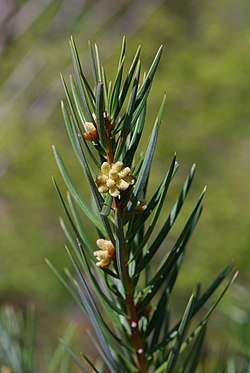| Keteleeria Temporal range: | |
|---|---|
 | |
| Keteleeria evelyniana leaves | |
| Scientific classification | |
| Kingdom: | Plantae |
| Clade: | Tracheophytes |
| Clade: | Gymnospermae |
| Division: | Pinophyta |
| Class: | Pinopsida |
| Order: | Pinales |
| Family: | Pinaceae |
| Subfamily: | Abietoideae |
| Genus: | Keteleeria Carrière |
| Type species | |
| Keteleeria fortunei (Murray) Carrière | |
Keteleeria is a genus of three species of coniferous trees in the family Pinaceae first described as a genus in 1866. [1] [2]
Contents
The genus name Keteleeria honours J.B. Keteleer (1813–1903), a French nurseryman. The group is related to the genera Nothotsuga and Pseudolarix . It is distinguished from Nothotsuga by the much larger cones, and from Pseudolarix by the evergreen leaves and the cones not disintegrating readily at maturity. All three genera share the unusual feature of male cones produced in umbels of several together from a single bud, and also in their ability, very rare in the Pinaceae, of being able to coppice.
The genus is found in southern China (from Shaanxi south to Guangdong, Yunnan and Hainan), Hong Kong, Taiwan, northern Laos, and Vietnam. [3]
They are evergreen trees reaching 35 m (115 ft) tall. The leaves are flat, needle-like, 1.5–7 cm (9⁄16–2+3⁄4 in) long and 2–4 cm (13⁄16–1+9⁄16 in) broad. The cones are erect, 6–22 cm (2+3⁄8–8+11⁄16 in) long, and mature in about 6–8 months after pollination; cone size and scale shape is very variable within all three species.
The variability of the cones has led in the past to the description of several additional species (up to 16 'species' have been named), but most authorities now only accept three species. Flora of China, however, recognized five. [4]
